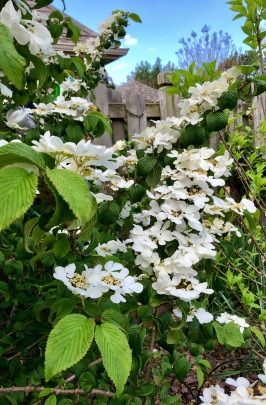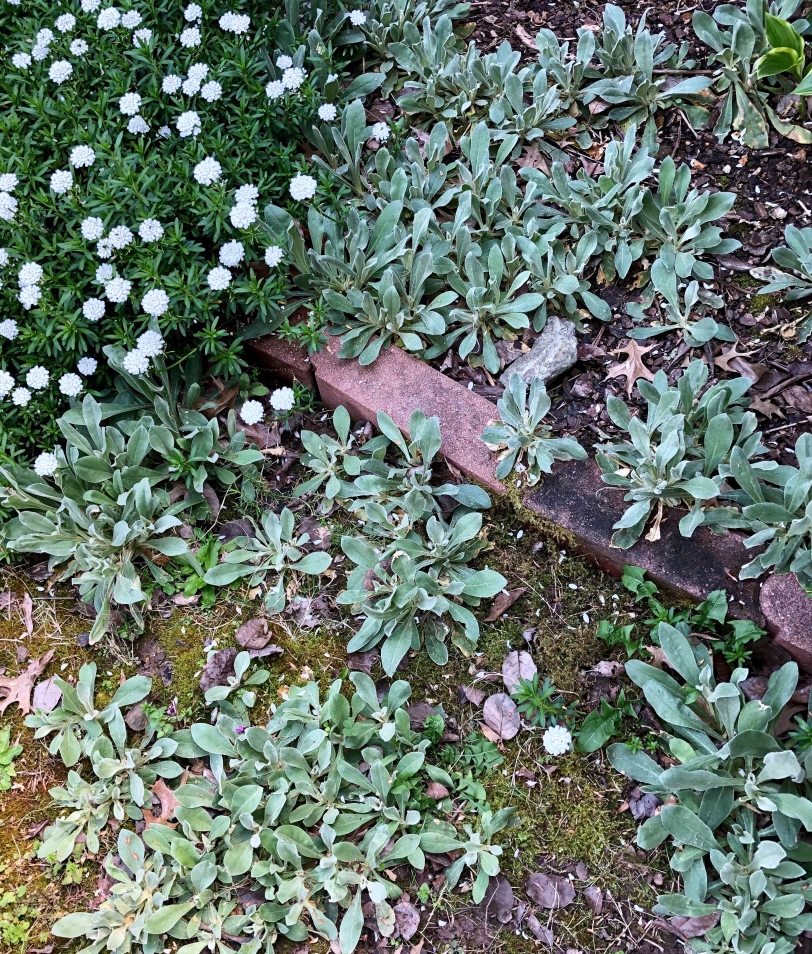I did not think that I’d have another six interesting observations to pass along for a third week in row, but I found that I do. Before I give my six for today, though, I want to pass along a provocative coincidence. At this past week’s Master Gardener meeting, a friend showed me two camellias that look exactly like two in one of my photos from last week. Her Candy Cane Camellia japonica had produced some red and pinkish-red blooms the same as mine had (https://aftereden.blog/2019/03/30/six-on-saturday-30-march-2019/). I am not sure what to conclude about this, so on to the first of six for this Saturday.
1. Doublefile Viburnum (Viburnum plicatum var.) cannot be surpassed for spring show. Its horizontal branching pattern with flat topped blooms in double rows, (hence double file) surprises me every year with its beauty. It also surprises me with its added growth. It is not the first shrub that I planted, and will not likely be the last one that I will plant, in a place too small for its mature development.



2. Forest Pansy Redbud (Cercis canadensis ‘Forest Pansy’) can give the doublefile viburnum a run for visual spectacle, though. The bright blooms on the nearly bare silver twisted branches are soon punctuated with immature heart-shaped purple leaves that are just as bright. The leaves will eventually turn to a deep maroon tinged green as the season moves on.

3. Serviceberry (Amelanchie arborea) is a small tree that produces these delicate blooms that develop into edible small fruits that the birds usually get to before I do. When I do harvest a few, they are good with yogurt or vanilla ice cream!

4. Candytuft (Iberis sempervirens) has jumped the bed this spring and made a lovely display carpet of white and green. There is not much more I have to say about this other than that what you see below is half in the lawn. But I am not inclined to cut it back at the moment.

5. Rose Campion (Lychnis coronaria) has also jumped the bed as it always does, and I am fully inclined to eliminate some of it. The deep pink flowers when they bloom are attractive, but the plant is entirely undisciplined.

6. Mouse Ears Hostas are charming. Given the shape of their leaves, it is easy to see where their names come from. The two in this pot are Hosta ‘Frosted Mouse Ears’ and Hosta ‘Blue Mouse Ears’ with tiny pointed and elongated leaves of ‘Little Devil’ peeking out from under the blue mouse ears. These hostas stay small, although the blue mouse ears will get a little larger, but certainly not out grow this 10 inch pot.

Again, I encourage my After Eden gardener followers to give Six on Saturday a try. Guidelines are easy to follow: https://thepropagatorblog.wordpress.com/2017/09/18/six-on-saturday-a-participant-guide/


Beautiful photos! Enjoying learning the names of what’s blooming this spring.
LikeLiked by 1 person
Doublefile Viburnum is a new one for me and I agree, it’s a very pretty flower. Candytuft is such a reliable plant isn’t it? It’s always one of the first to flower here.
LikeLiked by 1 person
I love the hostas. I haven’t seen the mouse ear ones before I wonder if they are available in the UK
LikeLiked by 1 person
There are several mail order companies that sell mouse ear hostas. I am certain you can find them in the UK. But be careful. Once you begin, you may want lots of them.
LikeLike
Beautiful, Susan!
LikeLike
I am sorry that I did not respond to your concerns about the camellia last week. I was distracted by the buckeye. Those variegated camellias, like so many plants with variegated flowers or foliage, are genetically unstable. Just like variegated foliage can revert to unvariegated, flowers can revert to one color or another, or both on the same plant. ‘Peppermint Stick’ flowering peach blooms with mostly red striped pink and whit flowers, but can produce stems with brick red, light pink or white flowers. It is considered an attribute for that cultivar. however, for camellias, it is not always an attribute. If you notice that a particular stem is producing the odd flowers, it is likely a ‘sport’, which is simply a mutant growth. Unvariegated (foliage) sports are a problem for variegated plants because they have more chlorophyll, so grow faster and overwhelm and replace the desired variegated foliage. Sports that are expressed only in bloom are not any more vigorous than the rest of the plant, but can become prominent parts of such plants if allowed to grow. Therefore, if you notice that a particular stem is producing flowers of the same sort of errant color or pattern, and you prefer the original color or pattern, it is best to prune it out while young. Such stems should be pruned below where the errant flowers were first noticed. If you notice more later, you can prune lower. However, it is more likely that the errant color originated in the development of the floral buds, and will be gone as soon as the flowers fall from the parent plant, so do not need to be pruned out. If you noticed several odd flowers on different stems in different locations on the main plant, particularly if you had never noticed them before on those stems, then that is probably what happened. If so, nothing more needs to be done.
LikeLiked by 1 person
I should also mention that I believe the variegation of your camellia is genetic, not viral. Viral variegation tends to be more blotchy.
LikeLiked by 1 person
This is very helpful, Tony. I’ll likely prune for shape and do nothing else.
LikeLiked by 1 person
That would probably be sufficient. If the off colored flowers get to be a bother, you can just observe where they originate from, and prune that piece or pieces out.
LikeLike
Finally, we get to the hosta. Always beautiful and much appreciated. Several years ago, we planted a variety of hostas in every conceivable space–following the example of a neighbor. But over the last few years, something has “gone wrong.” Once beautiful mounds of green are now barren, here and in the neighbor’s lawn. Is it possible that we have a virus (yes, viral issues took out the cannon lilies. 😦 )? The only plant that survives now with any regularity is the pachydermata. Green thumbs? Brown thumbs? all or no thumbs?
LikeLike
Lovely light in your photographs, and that Cercis is a real beauty this time of the year with its rich colours.
LikeLike